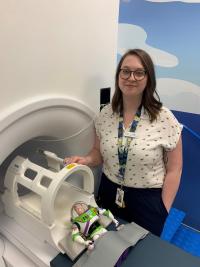Helping Children Cope: The Role of a Child Life Specialist in MRI
By Lisa Daechsel, HSA member
“I don’t want to be strapped to the bed” “I’m scared of loud noises” “I hate needles” “There is no way my child can lay still for that long”
These are just some of the things that I hear from children and families regarding MRI imaging. For many children and families, the MRI experience can create fear and anxiety. This is one example where the involvement of a child life specialist can be beneficial.
As a child life specialist, my role is to help infants, children, youth and families cope with their hospital experience. Child life specialists are experts in child development and use evidence-based, developmentally appropriate interventions including therapeutic play, preparation, and education to reduce pain, fear and anxiety.
In the Medical Imaging department at BC Children’s Hospital, part of our role is to assess children’s ability to complete non-sedated imaging, as well as support children and families through procedures that are often considered painful or anxiety inducing. Our interventions include preparing the child and family using developmentally appropriate language, helping children understand diagnosis and procedures through play, working with the family to create a coping plan for procedures, and providing nonpharmacological procedural support before, during, and after painful or unfamiliar procedural interventions.
One procedure that is known to cause fear in children and youth is MRI scans. Many children have misconceptions about the scan and lack the confidence and information to be able to successfully complete imaging without the use of sedation. As child life specialists, part of our role is running the MRI simulator program. MRI simulator appointments are booked one-on-one with a child life specialist and allow children the opportunity to come in advance of their MRI scan to practice each element of their imaging. During the appointment, children are able to learn about each step of the scan, explore the equipment at their own pace, ask questions, clear up misconceptions and practice laying still inside our mock MRI machine. The result is a higher percentage of children that are able to complete their scan without any sedation, which results in decreased medical risk for patients and utilizes fewer resources during their visit. Having more children able to complete non-sedated imaging in turn creates decreased wait list times for MRI scans at BC Children’s Hospital. In 2020, there were 265 patients that were able to successfully complete their MRI without sedation following a child life simulator appointment.
During this intervention, we are able to address each child’s unique needs and create coping strategies in collaboration with the family to support children in having a positive experience with their imaging. After we have completed our assessments, we are also able to support children on the day they return for their actual imaging, whether it is for a sedated scan or a non-sedated scan. Child life specialists are fully integrated with the team of nurses, technologists, radiologists and other staff in medical imaging and are considered an essential part of departmental operations.
One of my favorite parts of my job is meeting a child when they arrive for a simulator appointment, often shy, fearful, and hesitant and then watching the same child leave at the end of the appointment expressing excitement and confidence for their MRI. Many parents are initially doubtful that their child will be able to successfully tolerate the equipment and sounds of the MRI while also laying still for extended periods of time. After the appointment, I often hear parents expressing how proud and surprised they are that their child was able to conquer their fears during the appointment.
Child life specialists make up a fairly small part of the HSA membership but are an essential role within the world of pediatrics. To learn more about the child life profession visit childlife.org.
This article first appeared in the Winter 2021-22 edition of The Report magazine.